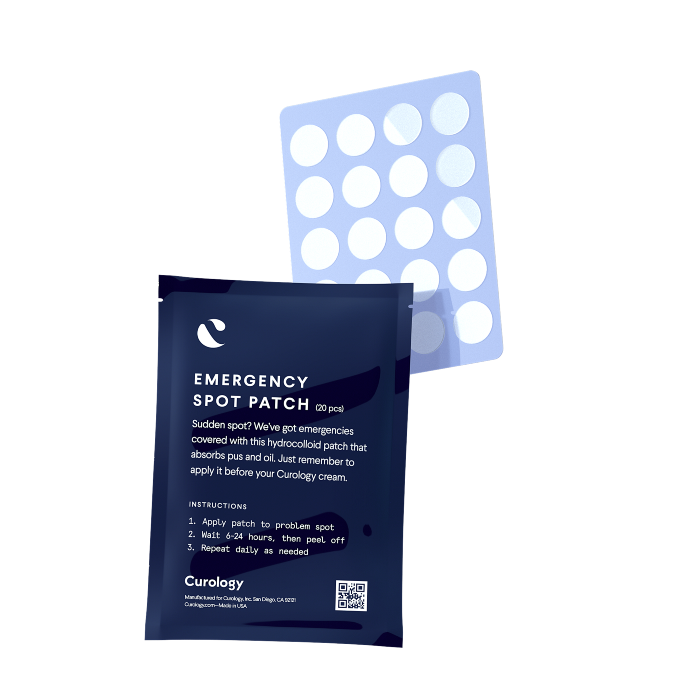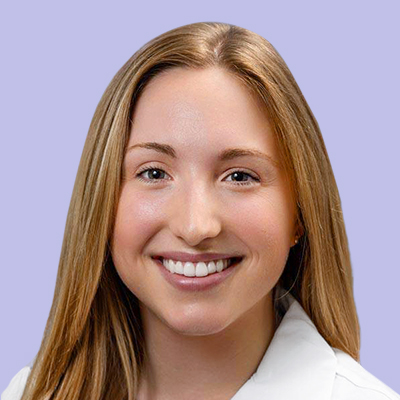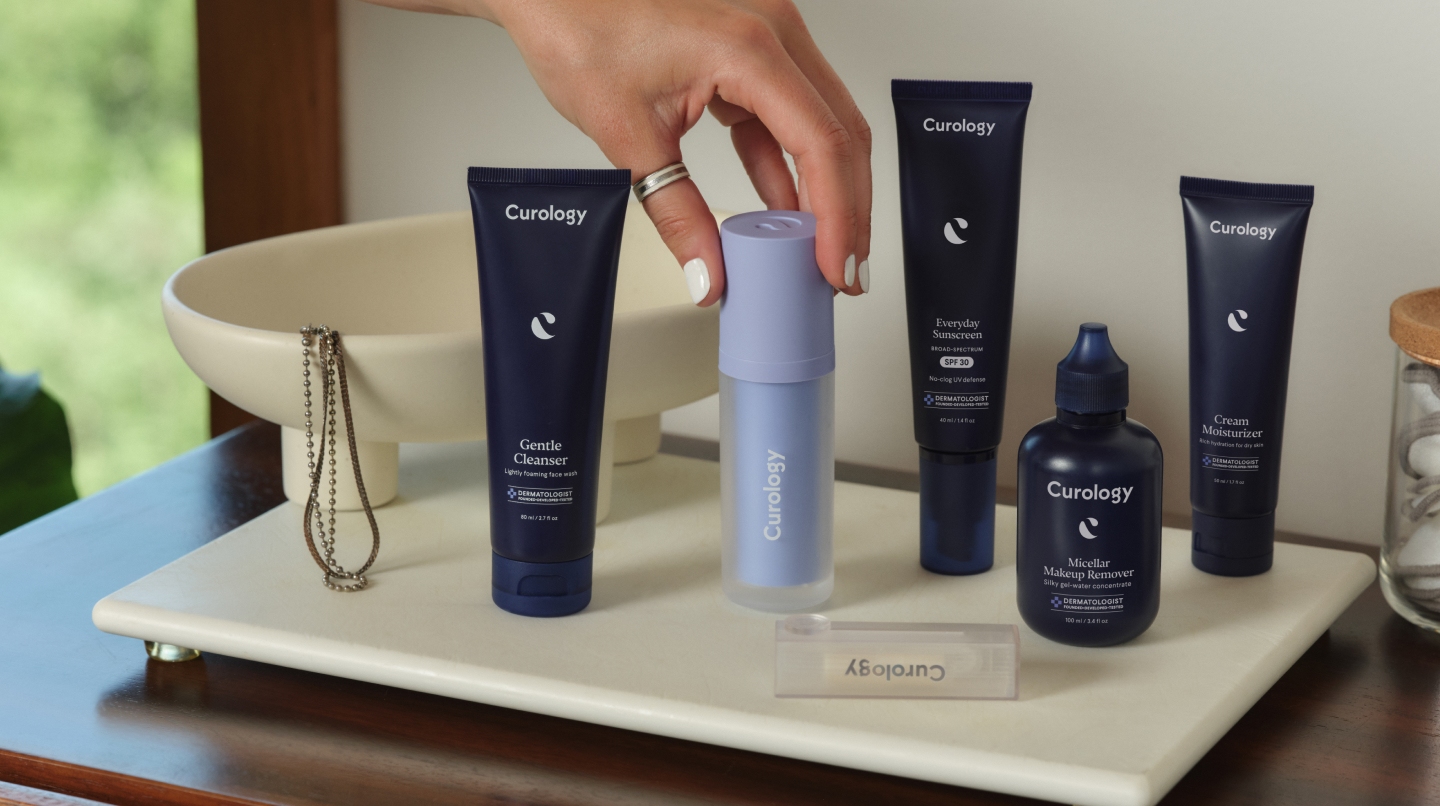How it works:
Share your skin goals and snap selfies
Your dermatology provider prescribes your formula
Apply nightly for happy, healthy skin
How it works:
How it works:
Share your skin goals and snap selfies
Your dermatology provider prescribes your formula
Apply nightly for happy, healthy skin
How it works:
How to get rid of pimples overnight and reduce inflammation
Trying to get rid of pimples fast? Check out these easy remedies.



Pimples often pop up at the worst possible time. And some stick around for what seems like an eternity! Squeezing, pinching, and popping only make them worse, so what can be done for immediate relief?
Fortunately, there are options to minimize “angry” pimples by reducing inflammation and redness. Here we’ll explain a few simple tips to help make acne treatment more effective. We also have five effective strategies to help decrease redness, plus different OTC and prescription ingredients to help keep acne at bay.
How to reduce pimple redness overnight
Sadly, there’s no surefire way to get rid of a pimple overnight. But there are things you can do to reduce redness and inflammation. Namely, proper preparation can help make overnight acne treatments more effective. Here are a few methods:
Wash your face
Cleansing should already be part of your nighttime skincare ritual, but it’s essential if you want the most from overnight quick fixes for inflamed acne. Follow these guidelines for clean skin:
Remove makeup using micellar water or another face wash formulated to remove makeup, but avoid scrubbing. You can try Curology’s Micellar Makeup Remover.
Use a gentle cleanser for acne-prone skin or your specific skin type, such as the hydrating, non-comedogenic cleanser by Curology (aka Gentle Cleanser). Splash lukewarm water on your face before applying a dab of cleanser in circular motions.
Rinse and pat dry with a clean, soft towel, being mindful not to aggravate any pimples. Wait 10–20 minutes for your face to completely dry before adding any acne spot treatments.
Switch your pillowcases and sheets
Although there is no proven connection between pillowcases and breakouts, it certainly won’t hurt. Not only does sleeping on fresh, clean sheets feel amazing, but it may help prevent further irritation of a breakout. The friction of your skin against sheets laden with perspiration, oil, or product residue may worsen or even potentially contribute to a breakout.
It’s generally a good idea to change your sheets weekly, but if you’re planning to zap a zit using one of the remedies below, don’t wait until the end of the week to change your sheets.
How to get rid of pimple redness fast
Quickly eliminating pimples can be as simple as using dermatologist-designed hydrocolloid bandages (like Curology’s Emergency Spot Patch) or other OTC options, trying certain DIY home remedies, or paying your dermatology provider an in-office visit.
Here’s a list of remedies to help get rid of pimples ASAP:
1. Hydrocolloid bandages
Hydrocolloid bandages work by absorbing the contents inside the pimple, which helps reduce the appearance of big zits. They attract pus and oil from inflamed spots and can promote faster healing by maintaining moisture. Spot patches can usually be worn overnight or for up to 24 hours.
If you use a spot patch, avoid applying topical acne treatments underneath the bandage. Not only does it reduce their adhesion, but it can cause irritation.
The Curology Emergency Spot Patch is thinner than the average patch, so it’s less visible for daytime use, especially if you layer a little foundation over the top. And it’s gentle enough for sensitive skin.

2. OTC spot treatments
Many over-the-counter spot treatments use benzoyl peroxide and salicylic acid. These often quickly and effectively reduce pimples but may also irritate the skin. Both ingredients work by drying out the pimple (as opposed to drawing out the pus).
Another option is Neutrogena’s On the Spot Acne Treatment. It uses a lower strength (2.5%) of benzoyl peroxide, so it’s generally less likely to be irritating. For best results, apply spot treatment using a clean cotton swab
3. Green tea cold compress
A cool green tea bag is a simple DIY treatment to help reduce pimple redness overnight. Green tea polyphenols have demonstrated anti-inflammatory properties.¹
To use green tea as a cold compress, steep a tea bag in one cup of boiling water for 5–10 minutes. Place the tea bag in the freezer for another 5–10 minutes. Gently press the chilled tea bag against the pimple for 20 seconds or until the skin starts to feel numb. Rest and repeat for up to five minutes, alternating on and off.
4. Diluted tea tree oil
Tea tree oil (aka melaleuca oil) is shown to be effective in reducing the number of acne lesions in those with mild-to-moderate acne.² However, it should be diluted in a carrier oil to avoid irritating the skin. Dilute one part tea tree oil with three parts of your preferred carrier oil; we recommend sunflower, castor, or jojoba oil as they’re non-comedogenic.
Avoid coconut oil, which can clog pores and make breakouts worse. If you’re unsure if the oil you’ve selected is comedogenic, we keep an updated cheat sheet of pore-clogging ingredients.
5. Cortisone injection
When a larger blemish appears, a cortisone injection may help. A licensed dermatology provider can administer a dilute cortisone medication called Kenalog (aka intralesional injection).
Cortisone injections can generally be repeated every 4–6 weeks, but this really shouldn’t be a “go-to” for treating inflamed acne. You’re better off sticking to a regular skincare routine with a hydrocolloid bandage, topical OTC acne product (like our Acne Cleanser), and/or prescription acne cream.
Common acne types and treatments
Acne forms when hair follicles (pores) become clogged with excess oil and dead skin cells. This in combination with bacteria and complex inflammatory mechanisms leads to acne.³ Inflammatory acne results in red lesions. Non-inflammatory acne includes open and closed comedones (blackheads and whiteheads). Here’s what you need to know about the different types of acne:
Whiteheads and blackheads are non-inflammatory blemishes. Whiteheads are closed comedones where a white pus-filled head forms. Blackheads are open comedones. The dark color results from oxidation. Whiteheads and blackheads form on the skin’s surface.
Papules and pustules are inflammatory acne that forms beneath the skin’s surface. Papules are red bumps that may be tender, and pustules are inflamed pimples with a pus-filled central core. These lesions are generally smaller than 5 millimeters in size.
Nodules or cysts are terms used to describe larger acne lesions. They are large and form deep within hair follicles. These lesions tend to hang around longer than usual.
Non-inflammatory acne can usually be treated with OTC topicals, such as benzoyl peroxide and salicylic acid. Inflammatory acne may respond to OTC treatments, but prescription-strength creams are typically more effective. Common topical acne treatments include the following:
Benzoyl peroxide is a common OTC antimicrobial used to treat acne. It’s also the star ingredient in the Curology Acne Cleanser.
Salicylic acid is an oil-soluble beta-hydroxy acid. It helps unclog pores. Salicylic acid is featured in Curology’s Acne Body Wash, which treats breakouts on the back, neck, chest, and shoulders.
Topical retinoids, such as tretinoin (available by prescription only) can also help. Tretinoin treats acne and helps prevent new breakouts. It also boosts collagen production and improves skin texture by stimulating cell turnover.
The Curology approach to acne treatment
Get your personalized skincare routine with Curology
Get your personalized skincare routine with Curology


If other acne solutions aren’t working, a personalized formula with prescription-strength ingredients from Curology can help. We’re here to help take the guesswork out of skincare. As a Curology member, you’ll gain access to one of our in-house licensed dermatology providers who will work with you to help you achieve your skin goals, whether that means treating acne, signs of aging, or hyperpigmentation. Plus, we’ll walk you through acne face mapping and proper skincare, answer any skin-related questions, and tweak your formula as your skin naturally changes.
FAQs
Not really. Blackheads typically form in groups across the nose (and other areas of the face). Pore strips promise to clear blackheads, but they can be irritating if not used correctly. Implementing a skincare routine with a gentle exfoliant is a great way to get rid of blackheads. Exfoliating won’t work overnight, but regular use can promote better skin over time.
A simple and consistent skincare routine is one of the best ways to treat and prevent acne. We advocate a simple three-step routine. At night, cleanse, treat, and moisturize. In the morning, cleanse, moisturize, and protect with broad spectrum sunscreen with SPF 30 or higher.
P.S. We did the homework so you don’t have to:
Katiyar, S.K., et al. Green tea and skin. Arch Dermatol. (August 2000).
Hammer, K.A. Treatment of acne with tea tree oil (melaleuca) products: A review of efficacy, tolerability, and potential modes of action. International Journal of Antimicrobial Agents. (February 2015).
Zaenglein, A.L., et al. Guidelines of care for the management of acne vulgaris. Journal of the American Academy of Dermatology. (May 2016).
Elise Griffin is a certified physician assistant at Curology. She received her Master of Medical Science in physician assistant studies from Nova Southeastern University in Jacksonville, FL.
* Subject to consultation. Subscription is required. Results may vary.

Curology Team

Elise Griffin, PA-C
Related Articles
Foundation makeup for acne-prone skin10 tips for using tretinoin in a skincare routineMen skin care: top concernsHow to get rid of body and back acne?Sunscreen for eyes: How to protect your delicate skin from UV raysPopular Articles
Ask Curology: Is my cold breaking me out?Slugging: The dermatologist-approved skincare hack going viral on TikTokTretinoin vs retinol: What’s the difference?How to create a self-care routine that actually sticksYour 2023 skincare horoscopeTry prescription skincare
Get routine essentials

Good skin days ahead
- Breakouts
- Redness
- Fine lines
- Dark spots
- Hair thinning